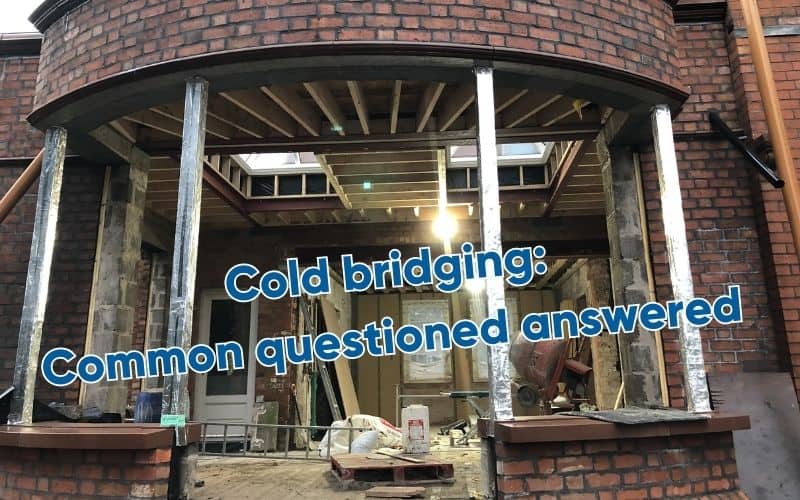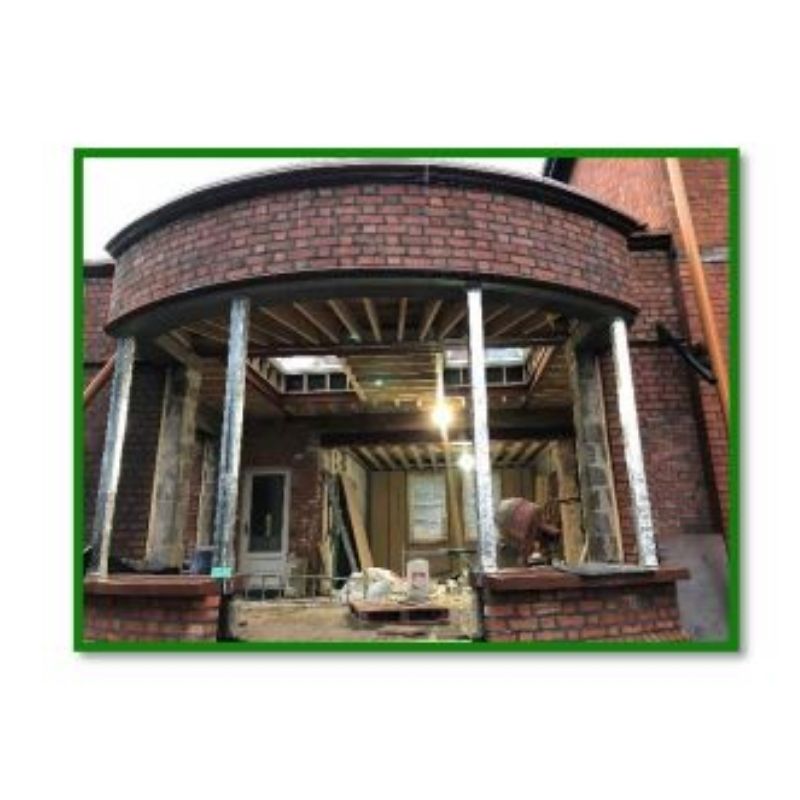Cold Bridging: Causes, Solutions, and the Difference from Thermal Bridging
Cold bridging is a common issue that can compromise the energy efficiency and comfort of a building. In this article, we will explore the causes of cold bridging, discuss the difference between cold bridging and thermal bridging, and provide practical solutions to prevent or minimize its effects. Whether you are dealing with cold bay windows or seeking ways to eliminate thermal bridging, this guide will help you understand and address these concerns effectively.

What causes cold bridging?
Cold bridging, also known as thermal bridging or heat bridging, is primarily caused by materials or components in a building’s structure that have higher thermal conductivity than the surrounding insulation. This leads to localised areas of increased heat transfer, resulting in cold spots and potential condensation issues. Here are some common causes of cold bridging:
- Building elements with high thermal conductivity: Materials such as metal, concrete, or uninsulated masonry have higher thermal conductivity than insulation materials. When these materials come into direct contact with the interior and exterior environments, they create paths for heat to escape or enter, causing cold bridging.
- Structural components: Structural elements, such as steel beams, concrete columns, or wood studs, can act as thermal bridges since they conduct heat more readily than the surrounding insulation. These elements often penetrate the building envelope, allowing heat to flow across them.
- Wall ties and fasteners: Metal wall ties or fasteners used in masonry construction can conduct heat and create thermal bridges if not properly insulated or spaced. They can provide a direct path for heat transfer between the interior and exterior of the building.
- Window frames and sashes: Window frames made of materials with high thermal conductivity, such as aluminum, can contribute to cold bridging. Inefficient or improperly installed windows can allow heat to escape, resulting in cold spots near the window frames.
- Junctions and corners: Corners, junctions, and intersections between different building components, such as walls, floors, and roofs, are areas prone to cold bridging. These areas often require careful detailing and insulation techniques to minimise thermal bridging.
- Inadequate insulation or gaps: Insufficient insulation or gaps in the insulation layer can lead to thermal bridges. These gaps can occur during installation or over time due to settling, degradation, or improper sealing. Any breaks or interruptions in the insulation can create pathways for heat transfer.
- Poor construction practices: Inaccurate installation techniques, lack of attention to detail, and insufficient quality control during construction can contribute to cold bridging. Improper sealing of joints, gaps, and penetrations can lead to thermal bridges.
By understanding the causes of cold bridging, builders, architects, and homeowners can take proactive measures to minimise its occurrence and improve the energy efficiency and thermal comfort of buildings. Proper insulation, careful detailing, and selection of materials with lower thermal conductivity can help prevent or reduce cold bridging.
What is the difference between cold bridging and thermal bridging?
Cold bridging and thermal bridging are related terms that refer to different aspects of the same phenomenon. Here’s the difference between the two:
Cold Bridging: Cold bridging refers to localised areas of a building’s structure where heat loss occurs more rapidly than in the surrounding areas. These areas become cooler than the rest of the building, creating cold spots. Cold bridging can result in discomfort, condensation, and higher energy consumption. It is typically caused by materials or components with higher thermal conductivity, such as metal or uninsulated masonry, that allow heat to escape more easily.
Thermal Bridging: Thermal bridging, on the other hand, refers to the transfer of heat across an assembly or structure due to materials or components with higher thermal conductivity. It occurs when there is a direct path for heat to flow between the interior and exterior of a building, bypassing the insulation layer. Thermal bridging can result in localised heat loss or heat gain, leading to reduced energy efficiency and potential issues such as condensation or discomfort.
In essence, cold bridging is a consequence or effect of thermal bridging. Thermal bridging is the underlying cause that allows heat to escape or enter more readily through certain areas of a building, while cold bridging refers to the observable result of localised heat loss, often leading to cold spots.
To mitigate both thermal bridging and cold bridging, it is important to employ strategies such as insulation, thermal breaks, and careful construction techniques to create a continuous thermal barrier and minimise heat transfer across the building envelope. By addressing thermal bridging, we can prevent or minimise the occurrence of cold bridging and improve energy efficiency and occupant comfort.
How do I stop my windows from cold bridging?
To stop windows from cold bridging, you can take the following steps:
- Insulate the window frame: Apply insulation materials, such as foam tape or these Aerogel strips, around the window frame to prevent air leaks and reduce heat transfer.
- Install thermal breaks: Thermal breaks are barriers placed between the interior and exterior components of the window frame to disrupt the flow of heat. They help minimise the transfer of cold temperatures from the outside to the inside.
- Upgrade to double or triple glazing: Replace single-pane windows with double or triple glazing. These windows have multiple layers of glass separated by insulating spaces, which reduce heat loss and improve insulation.
- Use low-emissivity (low-e) glass: Low-e glass coatings are designed to reflect heat back into the room while allowing natural light to enter. This helps maintain a comfortable temperature and reduces cold spots near windows.
- Consider window film or secondary glazing: Window film or secondary glazing systems can be applied to existing windows as an additional layer of insulation. They provide an extra barrier against heat loss and cold bridging.
- Seal gaps and cracks: Inspect the window area for any gaps, cracks, or drafts. Use caulking or sealant to seal these openings, preventing air infiltration and heat loss.
- Ensure proper ventilation: Adequate ventilation is essential to control moisture levels and prevent condensation. Properly functioning ventilation systems help maintain a healthy indoor environment while minimising the risk of condensation-related issues.
- Consult a professional: For more extensive window upgrades or if you’re unsure about the best solutions for your specific situation, it’s advisable to consult a professional in window installation or insulation to ensure the most effective methods are employed.
By implementing these measures, you can significantly reduce cold bridging around your windows, enhance energy efficiency, and improve the comfort of your living or working space.
How do you stop thermal bridging?
- Building envelope design: During the design phase, consider ways to minimise thermal bridging. Opt for a well-insulated and continuous building envelope that includes insulation layers without any interruptions or gaps.
- Thermal breaks: Incorporate thermal breaks into the building’s structure. These are materials with low thermal conductivity placed between components that conduct heat, such as concrete slabs, steel beams, or window frames. Thermal breaks interrupt the thermal path, reducing heat transfer and minimising thermal bridging.
- Insulation: Ensure proper insulation throughout the building. Use insulation materials with low thermal conductivity, such as foam boards, mineral wool, or cellulose insulation, to create a continuous thermal barrier. Pay attention to areas prone to thermal bridging, such as wall studs, corners, and junctions between different building elements.
- Continuous insulation: Implement continuous insulation techniques, such as exterior insulation systems or insulated sheathing, which provide a continuous layer of insulation across the building envelope. This helps to mitigate heat loss and reduce thermal bridging.
- Improved construction techniques: Train construction crews to follow best practices in insulation installation. Attention should be given to details such as properly sealing gaps, joints, and penetrations in the building envelope to minimise air leakage and thermal bridging.
- Use of thermal breaks in windows and doors: Select windows and doors with built-in thermal breaks or install thermal break strips around the frames. This helps to minimise heat transfer through these areas and reduces thermal bridging.
- Structural design considerations: If possible, explore alternative structural designs that reduce the need for structural elements with high thermal conductivity, such as steel beams or columns. Opting for materials with better insulation properties, such as wood or insulated concrete forms, can help mitigate thermal bridging.
- Energy modeling and analysis: Utilise energy modeling software to evaluate and identify areas of potential thermal bridging. This allows for targeted design modifications and optimisations to minimise heat transfer and improve overall energy efficiency.
Remember, thermal bridging can occur in various areas of a building, including walls, roofs, floors, and foundations. By implementing these strategies and considering thermal bridging prevention from the early stages of design and construction, you can significantly enhance the energy performance and thermal comfort of the building.
How do you deal with a cold bay window?
- Insulate the window: Apply the likes of these Aerogel strips or foam tape around the window frame and sashes to seal any gaps or air leaks. This helps prevent cold air from entering and warm air from escaping.
- Install thermal curtains or blinds: Use thick, thermal curtains or blinds to create an additional layer of insulation. These window treatments can help reduce heat loss through the glass and minimise cold drafts.
- Use window film or secondary glazing: Applying window film or installing secondary glazing systems can enhance insulation and reduce heat transfer. These solutions create an additional barrier against cold air infiltration and can improve the thermal performance of the bay window.
- Consider window inserts or insulating panels: Window inserts or insulating panels are removable and can be added to the interior of the window frame. These provide an extra layer of insulation and can significantly reduce heat loss and cold bridging.
- Address air leaks: Inspect the bay window for any noticeable drafts or air leaks. Seal gaps and cracks around the window frame, sashes, and junctions with caulking or weatherstripping to prevent cold air infiltration – we have a whole range of air tightness products that you can see here
- Upgrade to energy-efficient windows: If your bay window is old or inefficient, consider upgrading to energy-efficient windows with double or triple glazing. These windows have multiple layers of glass and insulating spaces that improve thermal performance and reduce cold spots.
- Consider window insulation films: Window insulation films, such as shrink films or heat-shrinkable plastic, can be applied to the interior of the glass. These films create an additional layer of insulation and help reduce heat loss through the window.
- Ensure proper ventilation: Proper ventilation is crucial to control moisture levels and prevent condensation. Ensure that your bay window has adequate ventilation options to maintain a healthy indoor environment while minimising the risk of condensation-related issues.
It’s important to note that the specific solutions may vary depending on the construction and design of your bay window. If you’re unsure about the best approach, consulting a professional in window installation or insulation can provide tailored recommendations for improving the insulation and thermal performance of your bay window.
Does wood stop thermal bridging?
Wood has a lower thermal conductivity compared to materials like metal or concrete, which means it conducts heat at a slower rate. While wood is not a perfect insulator, it is considered a better insulating material than metals or masonry. As a result, wood can help reduce thermal bridging compared to materials with higher thermal conductivity.
However, it’s important to note that even wood can still conduct some heat and allow for thermal bridging to occur. For example, in a wooden window frame, the areas where the glass meets the wood can still act as thermal bridges. Additionally, wood framing members in walls or roofs can conduct heat if they are not properly insulated or if there are gaps and breaks in the insulation layer around them.
To minimise thermal bridging with wood, it’s essential to use proper construction techniques and insulation strategies. Incorporating insulation materials with low thermal conductivity, such as foam boards or mineral wool, around wooden framing elements can help reduce heat transfer and mitigate thermal bridging. Paying attention to details such as sealing gaps, joints, and connections is also crucial to prevent air leakage and minimise thermal bridging.
Additionally, advancements in construction practices have led to the development of techniques and materials that further minimise thermal bridging with wood. For instance, some manufacturers offer insulated wooden frames or composite materials that incorporate insulation within the frame structure to enhance their thermal performance.
In summary, while wood has a lower thermal conductivity and can help reduce thermal bridging compared to other materials, it still requires proper insulation and construction practices to effectively minimise heat transfer and optimise energy efficiency in a building.
-
Shop options This product has multiple variants. The options may be chosen on the product page
Spaceloft Aerogel Strip Insulation for Posts, Windows & Doors
€17.95 – €27.50 (Inc. VAT)
My Build Club
Calling all Trades Professionals, Self Builders, Renovators and DIY lovers!
We have created an entirely unique section of our website that has been designed to make your life easier.
Enjoy discounts, get an even more enhanced level of customer service, find all your paperwork easily and get unique offers and deals regularly.
My Build Club is a brand new innovative service for all Self Builders, Renovators, Trade Professionals and DIY lovers in Ireland.
We have revolutionised how you can source the right products at the very best prices along with putting you in touch with real life experts to help you every step of the way.
Why join today?
- Save money and time when sourcing the supplies you need
- Get Trade discounts just like you would at our Trade Counter
- On demand support from our experts – video calls, live chat and phone support
- All of your paperwork and invoices in the one place
- Arrange fast delivery – including to work sites




